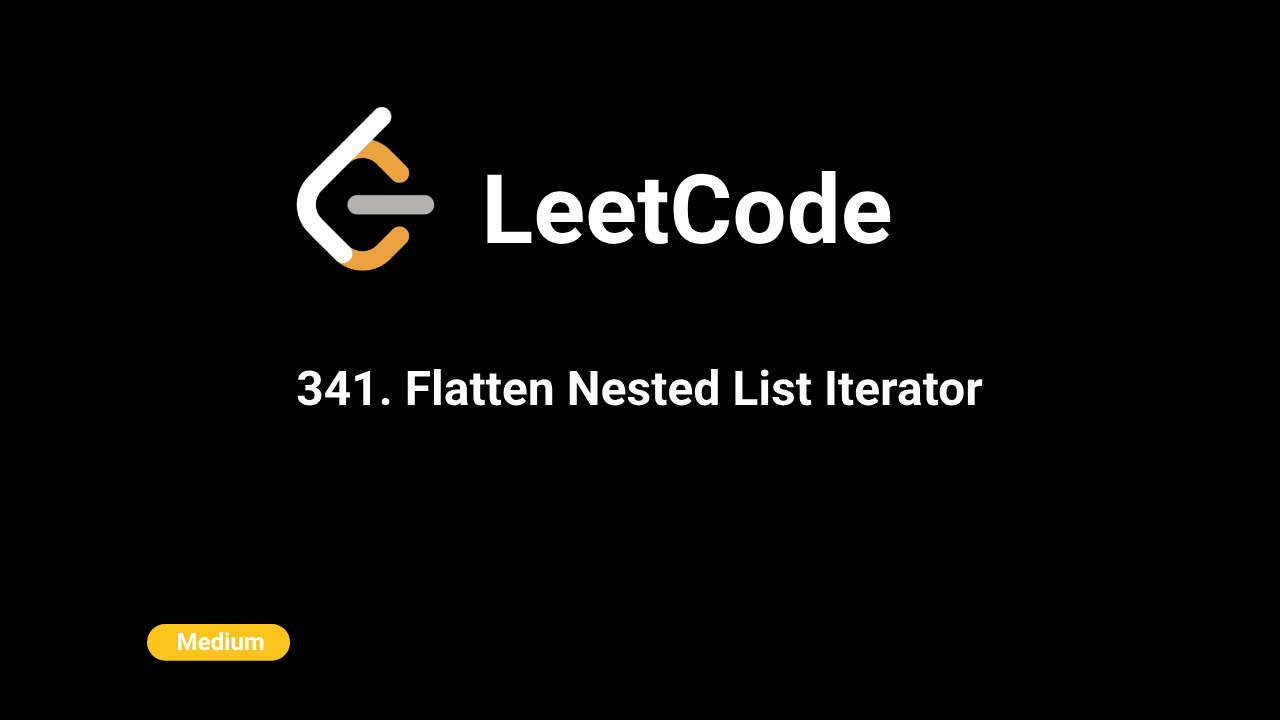
Description
The NestedIterator problem involves flattening a nested list of integers. A nested list can contain integers or other lists, and the goal is to design an iterator that returns all integers from the nested structure in a sequential manner. The iterator should support two operations: next() to get the next integer, and hasNext() to check if there are more integers to iterate over.
Intuition
The nested list structure can be represented as a tree where each integer is a leaf, and each list is a node that might contain other nodes or leaves. The key insight is to simulate a depth-first traversal of this tree, yielding integers whenever encountered. A stack or recursion can help in traversing the nested structure, keeping track of where we are in the nested lists.
Approach
- Initialization: Start by pushing the iterator of the initial nested list onto a stack (for iterative solutions). Each item can either be an integer or another list.
hasNext(): Check if the current element in the list is an integer or a nested list. If it’s an integer, returntrue. If it’s a nested list, push the iterator for the nested list onto the stack and continue checking. Pop the stack when a sublist is exhausted.next(): AssumehasNext()has been called, ensuring the iterator is at a valid integer. Retrieve and return the current integer and advance the iterator to the next position.- Recursive Approach (Python): The recursion keeps track of all nested lists by generating integers one by one, leveraging Python's
yieldto flatten the structure.
Complexity
Time Complexity:
The hasNext() and next() operations together visit each integer exactly once, thus the time complexity is proportional to the number of integers in the nested list, i.e., O(n), where n is the total number of integers.
Space Complexity:
The space complexity depends on the depth of the nested lists. In the worst case, if all the lists are deeply nested, the space complexity would be O(d), where d is the maximum depth of the nested list. In case of iterative solutions, it’s proportional to the depth of the list structure.
Code
C++
class NestedIterator {
stack::iterator> begins, ends;
public:
NestedIterator(vector &nestedList) {
begins.push(nestedList.begin());
ends.push(nestedList.end());
}
int next() {
hasNext(); // Ensure the iterator is at a valid integer.
return (begins.top()++)->getInteger();
}
bool hasNext() {
while (!begins.empty()) {
if (begins.top() == ends.top()) { // Current list is fully traversed
begins.pop();
ends.pop();
} else if (begins.top()->isInteger()) {
return true;
} else { // The current element is a list
auto &nestedList = begins.top()->getList();
begins.top()++;
begins.push(nestedList.begin());
ends.push(nestedList.end());
}
}
return false;
}
};
Python
class NestedIterator:
def __init__(self, nestedList: [NestedInteger]):
self.generator = self._flatten(nestedList)
self.nextVal = None
def _flatten(self, nestedList):
for item in nestedList:
if item.isInteger():
yield item.getInteger()
else:
yield from self._flatten(item.getList())
def next(self) -> int:
if not self.hasNext():
raise Exception("No more elements")
next_val = self.nextVal
self.nextVal = None
return next_val
def hasNext(self) -> bool:
if self.nextVal is not None:
return True
try:
self.nextVal = next(self.generator)
return True
except StopIteration:
return False
Java
public class NestedIterator implements Iterator {
private Stack> stack;
public NestedIterator(List nestedList) {
stack = new Stack<>();
stack.push(nestedList.listIterator());
}
@Override
public Integer next() {
hasNext(); // Ensure there's an integer ready to return.
return stack.peek().next().getInteger();
}
@Override
public boolean hasNext() {
while (!stack.isEmpty()) {
if (!stack.peek().hasNext()) {
stack.pop(); // Finished processing the current list.
} else {
NestedInteger x = stack.peek().next();
if (x.isInteger()) {
stack.peek().previous(); // Step back to handle it in `next()`
return true;
}
stack.push(x.getList().listIterator());
}
}
return false;
}
}
JavaScript
var NestedIterator = function (nestedList)
{
this.nestedList = nestedList;
this.iterator = flattenIteratorGen(this.nestedList);
this.currentValue = null;
};
/**
* @this NestedIterator
* @returns {boolean}
*/
NestedIterator.prototype.hasNext = function () {
if (this.currentValue !== null) {
return true;
}
const next = this.iterator.next();
if (next.done) {
return false;
}
this.currentValue = next.value;
return true;
};
/**
* @this NestedIterator
* @returns {number}
*/
NestedIterator.prototype.next = function () {
if (!this.hasNext()) {
throw new Error("No more elements to iterate.");
}
const value = this.currentValue;
this.currentValue = null;
return value;
};
const flattenIteratorGen = function* (nestedList) {
for (var item of nestedList) {
if (item.isInteger()) {
yield item.getInteger();
} else {
yield* flattenIteratorGen(item.getList());
}
}
};